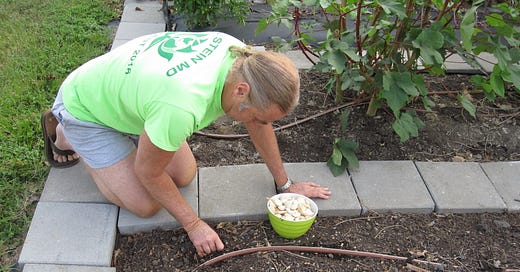Part 3: Growing Food
In central Texas, climate zones 8 and 9, I can grow some food in the winter such as brassicas, the cabbage family, including kale, broccoli, collard greens and cabbage, but I really just get the broccoli greens, not big florets. Brussels sprouts need more sunlight, and head cabbage needs more sunlight than we get in winter. To produce mass takes a lot of sunlight, but producing leaves does not take as much. (Adjust your hopes and aspirations to the realities of photosynthesis.) Onions and garlic do well over winter, planting in the fall, but they have a long season, and most of their growth happens when it is sunnier and warmer. Lettuces, radishes and beets (including spinach and Swiss chard) also produce well in winter in climate zones 8 and 9.
I worked out a succession-rotational gardening plan over a 3 year period, which accommodates the transitions between winter and summer crops, which are roughly: legumes, nightshades and other. I finally posted this on my old blog on July 4, 2016 as "Liberty Garden".
This is a complete and flexible plan for 3 beds to rotate through 3 years, or 5 beds to rotate through 5 years. http://www.johndayblog.com/2016/07/liberty-garden-central-texas-climate.html
In practice, I find that multiples of the 3 bed rotation scheme, with some differences in the rows, gives me the most flexibility, so I might use 3, 6, or 9 beds, for instance.
The rows are numbered for their succession in the arrangement.
The Summer Rows Include:
Nightshades- Tomatoes, Peppers, Eggplant and Potatoes. (Basil for convenience)
Legumes- Green Beans, Peas, Black-eyed Peas (African beans), Black Beans, etc.
Other- Okra, Corn, Melons, Squash, Cucumbers
Winter Rows Include:
Salads and Root Crops- Lettuces, Arugula, Radishes, Carrots, Beets and Beet Greens, such as Spinach and Swiss Chard
Alliums- Onions (short day type), Garlic, Leeks
Brassicas- Cabbages, Kale, Collard Greens, Mustard Greens, Broccoli, Brussels Sprouts > Resume at 1. Nightshades
If you don't have a winter growing season it is still good to have legumes in a bed every third year, because they fix nitrogen into the soil. Considering a 6 bed layout, you might want a bed for alliums (onions, garlic, leeks), brassicas (kale, cabbage, broccoli and brussels sprouts), and two separate beds for nightshades, one with tomatoes and peppers and one with potatoes and eggplant, for instance. If you want a row for salads, beets, spinach, chard and radishes, you would need to reduce to one nightshade bed.
The reason to keep beds in rotation is to avoid the buildup of pests and fungal disease in a bed, and to even out the nutrient extraction in the beds over time. Some vegetables are "light feeders" and some are "heavy feeders". Renewing compost top-dressing in the winter helps renew soil nutrients. You may compost your own garden and kitchen waste. You may take some garden cuttings to chickens at change of season, which is good , if it is something the chickens will eat. It is particularly convenient to purchase a truckload of the compost you want if you have a little truck, but it is less convenient to have it delivered, and most inconvenient and expensive to buy it in bags.
Sweet potato beds are different. First, don't buy the ornamental sweet potatoes at a nursery. They are white, hard and not very palatable. Buy the organic sweet potatoes in the fall, and grow the slips from them in water over the winter, or buy slips of specific types to plant in the spring. Sweet potatoes dominate a bed forever, coming back every spring, even if you dug "all" of them up in the fall. https://www.thespruce.com/how-to-grow-sweet-potatoes-in-the-home-garden-1403479
You will typically top-dress your sweet potato bed every winter and keep it watered, then dig them up in the fall when the leaves start to wilt and brown a bit. Sweet potatoes can be dug up at any time. They are always edible.
I have experimented with a banana patch over the past few years, but I may never get a ripe banana, because it takes about 18 months for one to grow, and winters would have to be milder than they have been for me to get bananas. If I were more practical, I would take the banana rhizomes ("corms") out and plant sweet potatoes. Maybe next year. Banana plants are so impressive in the fall, and hope springs eternal. (Pictures before and after a hard freeze).
Another experiment, one that is working well, is with cloches, little clear glass bowls to put over seedlings or young plants in the winter, to protect them from freezes. https://balconygardenweb.com/diy-garden-cloche-ideas/
These inexpensive glass bowls from Dollar Tree work fine, but they chip and break if stacked, so be careful. https://www.dollartree.com/clear-glass-bowls-6-in/986084
You can see them covering the stumps of some kale and spinach plants after harvesting the leaves before a winter storm. That worked well, and the tomato seeds I planted under them in December have mostly grown into small plants, which I just uncovered, since we don't have any freezes forecast for 10 days out, and we might be done with freezes (or not. I'm infamous for taking my chances before mid March).







This is great info for a so far unsuccessful vegetable garden grower! Thank you all!
Nice read!